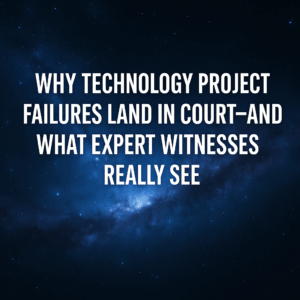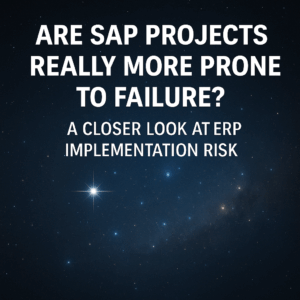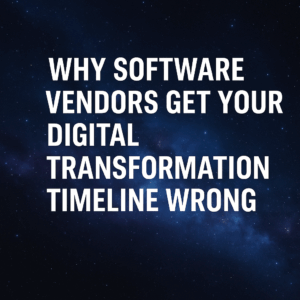There are a ton of overused and vague, ambiguous buzzwords used in the digital transformation industry. The ERP technology, digital transformation industry loves to create all kinds of buzzwords. It’s essentially a way to express the value and a way to speak a different language.
But the problem is that a lot of us don’t understand what any of this stuff means.
In today’s blog we will identify the top 10 business transformation buzzwords, what they actually mean, and how does it apply to your organization. So, let’s drill down (see what I did there) and unpack the top 10 industry buzzwords.
Table of Contents
Toggle1. Art of the Possible
Let’s start here. The first buzzword that’s commonly used in the industry is the term, art of the possible. A lot of ERP vendors, software vendors, system integrators will use that term to describe a sort of future state vision of how technology could help your organization.
Now, this is all great, but oftentimes this term is misused as sort of an emotional feel-good sort of thing that gets you convinced that you should deploy technologies that maybe you shouldn’t. Just because a more sophisticated advanced technology exists, it doesn’t necessarily mean it’s the right fit for your organization. So, art of the possible, take it for what it’s worth. Certainly, a creative future vision state, but recognize that art of the possible is a brilliant marketing message that actually means very little.

Remember, when you hear the term art of the possible, be sure you’re thinking of it in the context of what’s good for your business and what’s realistic for your organization, not the other way around.
2. Digital Core
Another term commonly used in this space is a digital core, and there are two meanings to this. There’s the real intended meaning, which is the “core” or central part of your business operations related to financials, inventory management, and technology that can help automate some of those core operations.
The second definition or meaning of digital core means, which is not the intended definition, but I’ll give it my own definition, is that a lot of technologies are not yet mature enough to deal with anything but the digital core. Software vendors will talk about how clients don’t need to worry about all these advanced technologies, partly because they’re not fully developed or baked yet.
This is a sales tactic so clients will focus on the part of the software that works well, and hide the underdeveloped areas that don’t work so well. At the end of the day, digital core is a real thing, but it’s important to understand to ask yourself If you’re implementing a core ERP system and, what are those outlying technologies that may not be fully baked yet. Make sure you understand what those weaknesses are, as part of your software evaluation process.
3. Future Proof
What might be the most annoying term in this top 10 list, in my opinion, is the term future proof. I personally don’t think there is any such thing as something that’s future-proof, but I still hear it often. What vendors and people in the industry typically mean by that is implementing technology that makes you as an organization, future-proof.
If you think that technology is going to help you be future proof, then you probably have bigger problems to deal with. Be sure to recognize this term for what it is, which is basically saying we have a great new emerging technology that will advance your business, but at some point, that technology will indeed be obsolete and you’ll have to replace it. Just like every other technology you’ve probably implemented within your organization. So be leery of the term future proof but recognize the benefit of it as well.
4. Humancentric
Another example of industry analysts with too much time on their hands is the term human-centric. Human-centric is intended to mean that it’s technology or change or transformation that’s focused on humans and is adaptable by humans.
I would argue that no technology on its own is going to be easily adapted by humans. You need organizational change management to help guide people through the transformation and the adoption of technology. The term humancentric suggests that the technology itself can easily be adopted.
While the technology has advanced to become more intuitive, better user interfaces, and things of that nature – it’s still a big change for most organizations. When you hear the term humancentric, don’t think of it as a silver bullet. But rather, think of it from an organizational change perspective and adaption.
5. Customer Experience
This is a term that I actually think has a lot of value. It has a clear definition if you use it appropriately. Customer experience is really using technology and your view of technological/operational changes from the context, through the lenses of your customers.
- What is their interaction with your organization and with your team look like?
- How can you improve that customer experience?
- What makes it easier for them to do business with you?
Some examples might include CRM or customer relationship management. That’s an example of a technology that can help with your customer experience. Even some back-office functions or technologies like manufacturing or warehouse management, those sorts of technologies also provide a better customer experience because it optimizes product delivery or better service to your customers.

Think about customer experience from that regard, and really viewing your process improvements not just to improve or change processes, but to do so in the context of how you can optimize your customer experience.
6. Employee Experience
Sixth on our list is another term that I actually think holds a lot of value, which is the concept of employee experience. Employee experience is similar to customer experience, except we’re focused on our own employees rather than customers. The reason this is so important is because it gives us another lens through to evaluate technological and operational changes.
This can provide insights on how to most effectively manage our transformation to ensure that people within our organization are actually able to have a better experience and have an easier job. We want our people to be more productive, efficient, and satisfied in their roles. Again, it’s just a different lens of looking at or evaluating your project and making sure that you’re delivering something that’s usable and adaptable for your own employees.
7. Big Data
Big data is another term that’s commonly used in the industry. This is another real term that has influence and tangible meaning. What big data essentially means is if you think about the average organization that has decades of transactions history, master data, customer transactions, financial reports, etc., These companies have massive amounts of data that get accumulated over time. That in and of itself is sort of what big data is.
What big data really is, is taking all that data and now managing it. Providing better visibility and action to that data. Things like business intelligence and predictive analytics could be examples of ways that you can leverage big data to add more value to your organization.

Big data is what I would consider a good trend and a positive initiative to focused on, because it forces you to think about how we don’t just accumulate more data and capture more data, but how do we make better use of it.

8. Industry 4.0
Industry 4.0 is another common term, especially if you’re in the manufacturing, distribution, or supply chain industry. Industry 4.0 is essentially the Fourth Industrial Revolution is what it’s technically referring to. What the Fourth Industrial Revolution is, it’s the automation of manufacturing and supply chains. While this has been going on for decades, this is nothing new in terms of the actual automation piece of it.
Now, we’re actually taking it to a whole other level of automation with the Internet of Things, with robotics, sensors on the shop floors, and collecting tons of data that we never had before. It’s a combination of automation, data capturing, and making use of that data to be more efficient, more effective, and more productive.
9. Resiliency
We often hear people talk about resilient organizations or resiliency as a priority in any sort of transformation. But… what exactly does that mean? Well, when we think of resiliency, we think of flexibility. We think of somewhat of agility and the ability of organizations to adapt to changing situations.
Think about the pandemic and how that impacted so many different businesses.
The most resilient organizations were the ones that were able to adapt quickly, be flexible, and do business in a new environment. The ones that weren’t so resilient were the ones that had the most trouble and, in some cases, failed.
When we think about resiliency as it relates to our transformation, we want to be thinking about, how can we build a flexible set of business processes that can quickly evolve within changing unexpected environments. Think about resiliency as one of the things you incorporate into your transformation.
10. Agile
Now, the final thing on our top 10 list is agile. Agile is something that’s similar to resiliency. It implies flexibility, but it also alludes to speed and the ability to deploy technology very quickly. This could be because you’re being disrupted in your industry, or it could be because you proactively want to roll out new technologies to get ahead of the competition.
Now, be leery of agile because, on one hand, you do want to be agile. You want to be fast but smart and deliberate, and through a strategic plan. Sometimes those two things can be in conflict or direct conflict.
If you can find the best of both worlds where you do take the time to plan and map out what your strategy. Outline a clear transformation roadmap, define your requirements and your future state processes, then when you go to roll out changes. You can do that in more of an agile nature. That’s the meaning of agile, which is a commonly used buzzword in the industry as well.
Resources
I hope this has helped explain and translate some of these buzzwords, as well as add some meaning through real-world examples of how they can be used within your organization.
For more information on digital transformation best practices and optimize your digital transformation, I encourage you to download our 2021 Digital Transformation Report.
If you’d like to discuss more digital transformation buzzwords or have any of your own not mentioned above, please reach out to me directly. I’m also happy to be an informal sounding board for your project or digital transformation journey.






